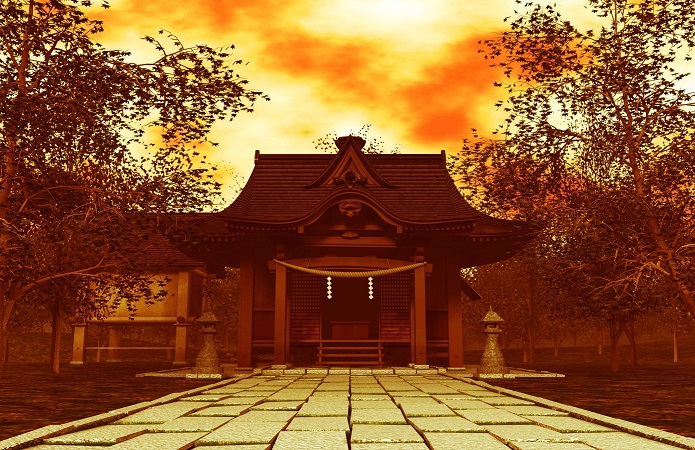
⛩ Yōhai ⛩
Performing yohai, remote reverence, is the best way for someone who is not in Japan and has no ofuda to take part in Shinto.
It's an interesting microcosm of Shinto practice and belief: the deliberate and precise movements, the act of directing reverence at a shrine and not a particular kami, the use of old Japanese in the prayer...
You can do this as often as you like. The 1st and 15th days of the month are considered a reasonable minimum. These days are thought to be the new moon and full moon in lunar calendar.
The more astrologically oriented can of course just use the cycles of the moon...
It's very important for yourself to clean yourself before doing this. If you are dirty or just have a half day's worth of sweat on you, take a shower. Otherwise washing your hands and rinsing your mouth is OK.
Considering the importance of salt in purification and it's use in other Shinto rituals, I don't think anyone would stop you from taking a salth bath or some such if you want to be extra about it.
Please also dress yourself as if you were to meet someone very important you respect very much.
Do your best to be as precise and exact with the yohai as possible. Shinto is very strict about doing things right, after all.
I don't think any harm will come from practicing the choreography of the movements, beyond your neighbours thinking you are weird when they start hearing the intermittent clapping.
The actual act of reverence is thought to begin from when you first bow your head and start reciting the main prayer.
⛩ Which shrine to choose? ⛩
It really is up to you. Strictly Touhou Project related options are the Suwa Daimyōjin and Jomine Jinja.
Suwa Daimyōjin is from where the Suwa mythologies that inspired Kanako-sama, Suwako-sama and Sanae-sama came from. I believe performing a yohai for this shrine is a beatiful way to honor their origins.
Jomine Jinja might be the shrine that served as a model for the Hakurei Shrine and thus, if you want to believe in such, might also enshrine the kami of Gensokyo.
Beyond that, some other options that might be of interest
Jingū - The Ise Grand Shrine, which enshrines Amaterasu Oomikami. Considering how important and respectable Amaterasu Oomikami is, this is an excelent option.
Fushimi Inari-taisha - This is where Inari Ookami, a kami associated with all kind of worldly success, is enshrined. There are 32 000(!!) branch shrines of this shrine.
Tenmangū - These enshrine Tenjin-sama, a kami associated with scholarship. If you study Japanese or desire to do so this might be of interest to you. Dazaifu Tenmangū and Kitano Tenmangū are the biggest ones.
It's generally thought you can revere only one shrine at a time. If you want to do multiples you have to do the yohai over again.
I think many would consider it reasonable to dedicate different days to different shrines.
⛩ Performing the Yōhai ⛩
Face towards Japan
Bow deeply twice
Harae tamai, kiyome tamae
Take three steps forward
Bow to 45 degrees
Stand up straight and pause for a couple of seconds
Bow deeply
Bow your head or bow slightly from your waist
Kakemakumo kashikoki (shrine name) no oomae o haruka ni orogami mutsurite
kashikomi kashikomi moosaku
Ookamitachi no hiroki atsuki mimegumi o katajikenami matsuri
Takaki tootoki mioshie no manimani naoki tadashiki magokoro
mochite makoto no michi ni tagau koto naku
Oimotsu waza hagemashime tamai
Iekado takaku misutokyaka ni
Yo no tamae hito no tame ni tsukusashime tamae to
Kashikomi kashikomi mo moosu
Straighten your head and body
Bow deeply twice
Stand up straight again
Put your hands together in front of your chest at about shoulder height
Slide right hand down slightly so that the tips of fingers are around the joints of the left hand
Clap your hands loudly twice, opening them to the width of your chest
Slide your right hand to be on the level with your left hand
Put your arms down by your sides
Bow deep once
Stand up straight and pause for a few seconds
Bow once down to about 45 and straighten up
Take three steps backwards - you should walk backwards
Bow slightly once
The reverence is now over.
⛩ Translations ⛩
The spoken part of the yohai translated to English would be as follows:
I ask that your purify and cleanse me
As I venerate the kami of (shrine), whose name it is fearful even to utter,
from a distant place, I pray that
I may humbly offer up the broad and deep blessings of kami with deep awe,
I may follow the true path without straying, in accordance with the
high and noble teachings of the kami, bearing an honest, true, and sincere heart
Give me energy for the work I do,
Raise up my household in health,
And enable me to give my all for the world and for other people.
I most humbly and reverently so pray
⛩ The extended harae ⛩
The "Harae tamai, kiyome tamae" is a harae prayer, a purification prayer, that follows other prayers.
There is a longer version that is apparently the standard that is used before a matsuri.
If you wish to perform the yohai more sporadicaly, I think putting the extra effort is a good idea.
Kakemakumo kashikoki Izanagi no Ookami
Tsukushi no Himuga no Tachibana no Odo no Awagihara ni
Misogiharae tamaishi toki ni narimaseru
Haraedo no Ookamitachi
Moromoro no Magagoto, Tsumikegare aramuoba
Harae tamai Kiyome tamae
To moosu koto o
Kikoshimese to
Kashikomi Kashikomi mo Moosu
This would translate as
Oh kami of harae, born when Izanagi no Ōkami
whose very name it is fearful to utter
performed misogiharae at the
Awagihara of Tachibana bay in Himuga in Tsukushi
whatever misfortune or tsumikegare there may be
we most humbly and fearfully pray
that you hear our entreaty to purify and cleanse it